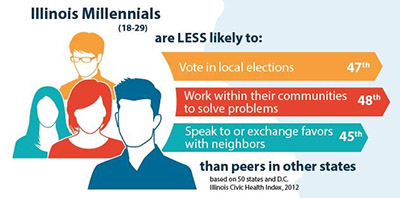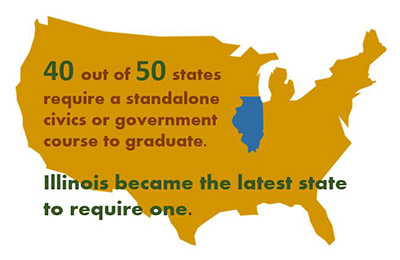
Why Civics?
Top 10 Benefits of Quality Civic Education
- Strengthens the basic understanding of our structures of government, along with related processes of legislation and policy making.
- Enhances “21st century competencies” that are valued by colleges, universities and employers.
- Closes the civic achievement gap across race, ethnicity, income and parental educational attainment.
- Lowers high school dropout rates.
- Creates a positive school climate that supports students feeling socially, emotionally and physically safe.
- Builds news literacy skills necessary for gathering information to make reasoned decisions on critical issues affecting our country.
- Increases volunteerism and work on community issues.
- Enhances democratic accountability of elected officials.
- Improves government transparency.
- Increases voting and discussions of politics in the home.
Justice Sandra Day O’Connor

The Civic Empowerment Gap
Meira Levinson, in her widely acclaimed 2012 book Leave no Citizen Behind, outlines a “…profound civic empowerment gap…between ethnographical minority, naturalized, and especially poor citizens, on one hand, and white, native-born, and especially middle-class and wealthy citizens on the other.” This gap is caused or exacerbated, at least in part, by our system of education. There is “…incontrovertible evidence that poor and non-white students are receiving demonstrably less and worse civic education than middle-class and wealthy white students.”
Civic Mission
The civic mission of schools is not a new concept. Our nation’s public schools were founded to develop citizens with knowledge, and the rights and responsibilities of self-government. Yet formal civic education has almost vanished from the curriculum in most schools.


Generational Civic Education
We must provide our youngest generation with the understanding of our constitutional system, and an appreciation for the achievements of, and opportunities provided by, self-government. Failure to do so will imperil the future of our democracy.
Fast Facts on Civic Education
America’s Civic Learning crisis: Preparation for informed and engaged citizenship is the co-equal goal of education: A Fact Sheet.
- Recognizing that individuals do not automatically become responsible participating citizens but must be educated for citizenship, the founders of our universal system of free public education made education for citizenship a core part of the mission of public education, equal to workplace preparation. This determination to educate young Americans about their rights and responsibilities as citizens is known as the civic mission of schools.
- Each state’s constitution or public education establishment statutes and codes acknowledge the civic mission of schools.
- Americans profess that the civic mission of schools is an essential—if not the essential—purpose of education. Over the course of 33 years of Phi Delta Kappa/Gallup polling on American attitudes on education, Americans have overwhelmingly concurred with the statement that “educating young people for responsible citizenship” should be the primary goal of our schools. Their conviction that the school’s central mission is educating young people for citizenship has not wavered over time, and it is consistent whether or not respondents have children in school and whether or not their children are in public or private school. (Annual Gallup/Phi Delta Kappa Poll of the Public’s Attitudes Toward the Public Schools)
- In a 2004 poll 91% of adults responded that they were more likely to support policymakers who support strengthening civic education in the schools. (“Citizenship: A Challenge for All Generations,” available at www.ncsl.org, ‘Trust for Representative Democracy’)
- Civic education helps form the attitudes of students in ways employers report seeking in their employees. Students who experience high quality civic learning are more tolerant of others, more willing to listen to differing points of view and take greater responsibility for their actions and to improve their communities. (Study conducted by Dr. Judith Torney-Purta for the Campaign for the Civic Mission of Schools released October 2009)
Sources
Center for Information Research on Civic Learning and Engagement: All Together Now: Collaboration and Innovation for Youth Civic Engagement. The Report of the Commission on Youth Voting and Civic Knowledge. 2013.
Kahne, Joseph, and Middaugh, Ellen: Democracy for Some: the Civic Opportunity Gap in High School. CIRCLE Working Paper 59. 2008.
Kawashima-Ginsberg, Kei: Do Discussion, Debate, and Simulations Boost NAEP Civics Performance? CIRCLE Fact Sheet. 2013.
Levinson, Meira: No Citizen Left Behind. Cambridge, MA: Harvard U. Press, 2012. Download the PDF
Sporte, Sue E., and Kahne, Joseph: Educating for Democracy: Lessons from Chicago. Chicago, IL: Consortium on Chicago School Research. 2007.
